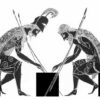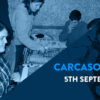Bill Hartston is a journalist, chess master, and award-winning author. He runs both the creative thinking world championship and the infamous quiz at the Mind Sports Olympiad.
Riva Kent is a participant of the Mind Sports Olympiad. She now lives in Israel where she runs Immersive Play www.immersive-play.com
Riva: How would you describe what the Creative Thinking World Championship is and how did it come about?
Bill: It came about as part of the Mind Sports Olympiad, which is a sort of a boardgame-athon, it’s a lot of people who’ve got nothing better to do other than play chess and bridge and poker and all sorts of other games. My wasted youth was in chess, so I had very good connections with the people who were running the thing, this was about twenty years ago when it started. I’m not sure whether they suggested it to me or I suggested to them a creativity competition. It was definitely they who called it the world championship, which I think is quite ridiculous, but it was a wonderful idea to have such a thing.
At the time I was writing for The Independent and one of the things I wrote was a column called ‘Creativity’ which was based on management psychology tests. One of the other things in my wasted youth was developing personality tests, working as a psychometrician. I read maths but the subject and I lost interest in each other while I was meant to be doing a Ph.D. So I went off and did all sorts of other things instead, one of which was working on this personality testing business. I developed personality tests and I came across some creativity tests, of which the most common form was the unusual uses for commonplace objects. You give someone a thing like a brick or a paperclip, or something else really mundane and ask them to come up with unusual uses for it. I’d been asked to come up with some ideas at the paper that would attract readers to contribute and so I thought that this creativity was a great one and would make a wonderful reader involvement newspaper column. Each week I would suggest one object and readers would come up with ideas for it. The first object I chose was an odd sock and the best response I got was unravel the wool in it and use it to knit the missing one. I thought that was brilliant.
But then if you knitted the missing one then you’d still have one odd sock…
Oh how terribly mundane of you. Yes, of course, you would but you’d have the other one. You’d have the one you were missing.
For people who aren’t familiar with what the Creative Thinking World Championship is, can you explain what it is.
It’s all writing based, I give them silly things to do and they do them. It might be an object to come up with silly ideas for. In the very first year I gave them a set of things that looked like intelligence test questions but they were asked to come up with unusual answers so one of the questions was “what is the next number in this series: 1, 2, 3, 4, 5” and of course you got no credit for saying 6. I asked them to come up with as many answers as they could for this and they had to provide reasons for them. And it was very interesting to see what they came up with. I can’t remember any of the answers now as it was so long ago. One of the questions was what is the next letter in this series, the series being “g, g, g, g, g, g”. The answer that I actually had in mind when I wrote the question was “h” because it is actually a series of the last letters of the days of the week in German starting on Thursday. It was just inviting them to come up with silly ideas. One of the questions last year or the year before, I had this idea when I was wandering through the market in Cambridge and I overheard a snatch of conversation. It was a group of three or four people and a woman was saying “and then when I woke up I was completely naked and I used the lobster things to cover my breasts.”
Yes, I remember that question…
I thought that that was so wonderful. So I spent some time just wondering around the market to pick up other lines and then asking people [in the Creative Thinking WC] to build them into a story.
Do you have a favorite question that you’ve ever asked in the competition?
I have a favorite answer. Which was, I once gave them a torn out bit of music manuscript, it was a bit of a Haydn piano sonata but nobody would know that. Just a few bars. And I said “in several thousand years time, future anthropologists dig this up when they know nothing about our civilization or music or anything like that. What do they make of it?” One contestant, who I think actually won the competition that year, produced a complete explanation of musical notation as if it’s mapping the places on telegraph wires that starlings are sitting prior to migration. The five lines in the stave were the telegraph wires, whether the notes were open or filled in (white or black) was whether they were male or female, which direction they were facing was the direction that the birds would fly off in, the bar lines were the telegraph poles. It just went on and on, she used everything that was in the picture in front of her to explain starling migration. I thought that it was brilliant.
Just to backtrack a bit to the Mind Sports Olympiad, what would you say is the place of the Creative Thinking World Championship. It seems quite different to the other competitions – they’re using logic and strategy and this is using creativity.
There is a huge connection between creativity and logic. Except logic tends to be a convergent process and creativity tends to be divergent. There is a book by Arthur Koestler called ‘The Act of Creation’ in which he discusses what creativity really is and he comes up with this word “bisociation” and says that the essence of all creativity is bringing together two ideas that are on parallel lines and that it’s a way of combining things, a way of seeing similarity where there wasn’t any before. It’s totally logical but it’s not a convergent logic, it’s not following all the information you’ve got and drawing conclusions from it. You have to draw the conclusion first and then make it fit. So it is very different from the other games but most games have room for creativity in them. You know, the people who play them by rote aren’t the good ones.
How do you mark the Creative Thinking World Championship? What is your criteria?
The way we used to mark the creativity tests as management tests with the unusual uses for commonplace objects was by looking at how many different dimensions people were seeing things in, how many essentially different ideas they were coming up with and whether these ideas were thought of by other people or not. So we were really looking for answers that were different from the mundane, that were lifted above the level that most people were putting. So if someone’s unusual use for a paperclip involves unwinding it and then picking their ear or nose with it that’s completely mundane. Someone who uses it as a branding iron for mice is getting a bit unusual.
I’ve seen people who run creativity courses. Personally, I don’t think that creativity can be taught but you can convince people that they’re being creative by giving them a sort of strategy to follow to come up with ideas that they wouldn’t have come up with before. So with the unusual uses, you can look at the shape of the object, the size, the colour, you can look at an object in any of those dimensions. Normally we look at all of them together. The French for paperclip is trombone and a paperclip looks just like a trombone so if you tried to turn a paperclip into a musical instrument, you’d get something trombone-ish. So you can get people to think outside of their usual way of doing so.
I used to mark the thing quite objectively, scoring 2 points for an idea that nobody else thought of and 1 point for an idea. Quite often people would come up with a lot of ideas that were all essentially the same thing so you’d only get 1 point for those. The way that I tend to mark all of the rounds now is to read through all of the responses, decide which one is best, which one appeals to me most, give that 25 marks and then mark all the others accordingly.
I did a radio programme years ago on creativity where I interviewed a lot of people and one question that I put to everybody was “whats the difference between a good idea and a bad idea?” And I don’t know a good answer to it.
Do you think that it’s just a matter of intuition? Like you can just tell?
I think that this is one of the differences between scientific creativity and artistic creativity. Scientists will tend to say that it’s a good idea if it works, but that’s not right – you can have a very good idea that just doesn’t work, that’s unlucky. And you can have a bad idea that does work. In art, the good ideas work. On some level they work, they don’t need to be popular, I don’t think. I don’t know. I really don’t know what the difference between a good idea and a bad idea is, or how one defines it.
You said that you don’t think that creativity can be taught, so are you saying that it is more natural as opposed to nurture? Some people are just naturally more creative?
I think that everybody is born creative, I think you have to be. When you realise what a baby is doing when it’s coming to terms with the world. We’re receiving sensory input through all our senses and we’re getting this absolutely muddled picture of sight, sound, taste, everything, and we have to form some picture of the world from it and it is a creative process. I once interviewed a professor of psychiatry whose main area was the development of children and he had this line that basically growing up is a limiting process. All children are ridiculously creative because they haven’t formed the patterns that they need to form to be able to function as human beings. Gradually we have all these rules imposed on us and we impose them on ourselves because it makes life easier. A lot of people end up being completely mundane and living their lives entirely by rules and never doing anything unexpected because they don’t know what’s going to happen if they do something unexpected. They talk themselves out of being creative.
One of the people that I interviewed on the radio programme was a guy who had been suggested to us by somebody that ran creativity courses. He was identified as a star pupil and he was one of the least creative people I’ve ever met. He was absolutely frantic before the interview and was constantly asking the producer of the programme “what questions are you going to ask me?” so that he could work out his replies. I said that it’s impossible to give you a list of questions because the questions will depend on your answers. But then I gave him a list, I satisfied him in the least, citing ten areas that I wanted to cover. When we sat down for the interview, I started with number six on the list and he absolutely panicked because he was only prepared to answer question one.
I think that you can draw people out, you can get them to look at things in different ways and they can feel that they’re being creative. But what they’re really doing is just applying a different set of rules and they should be inventing their own rules.
Some people might think of themselves as not very creative.
It’s a pity if they do because you have much more fun being creative.
How do you think that a person can develop their creativity? Can you suggest any thought processes, exercises or inspiration that might help a person?
Koestler divides his book ‘The Act of Creation’ into three sections and the third one is jokes. When you start trying to analyze jokes it gets very interesting because the way jokes work is by setting the listeners mind on one path when actually the story is going along on another and the punchline jumps from one path to the other. I think that analysing how this happens is a creative thought process. I think that actually starting with any question, finding the answer and then trying to think of other possible answers is a way to develop one’s creativity. We’re normally satisfied with just one answer but we need to realize that there can be others and that ideas are limitless.
I write a column called ‘Beachcomber’ in the Daily Express. When people ask me what it’s about I tell them that I write anything I want to as long as it’s silly. When my kids were at primary school I got volunteered for a day when dads come to school and explain what they do for a living. After getting the kids on my side by setting them some puzzles and throwing them sweets when they got the right answers, I then read some Beachcomber columns. I’d never really analysed how I write them before but I realised that one very common technique was to start with a slightly illogical premise and then pursue it with rigid logic ad absurdum.
One of the examples is having conversations with self-checkout machines in supermarkets. Once when I was in the supermarket and just buying a carton of milk I scanned it through, put it in the wonderfully named ‘bagging area’ and the voice of the machine said “unexpected item in the bagging area, please remove the item”, so I removed it. And then it said “please replace the item in the bagging area” so I put it back and then it said “unexpected item in the bagging area” and we got stuck in this loop. So for writing the piece I wrote the story up till then as it had happened but then I said to the machine “excuse me I’m in a bit of a hurry, I just want to buy the milk, do you want it in the bagging area or out of it?” and the machine then says “I’m sorry I’m having a bit of a difficult morning” and we then have this wonderful conversation with the machine and it starts with the slightly illogical premise that there is a person inside the machine who is actually saying these things. Or that the machine is lifelike, it’s giving it a proper identity. Over several columns, I’ve really developed this romance between me and the checkout machine.
Back to the Creative Thinking World Championship – when you set a question do you often have an answer in your head? Or is part of the fun not having any idea about how you would answer the question yourself?
That’s a very good question because at the start of me doing a creativity column in The Independent, I always thought about the thing first and what ideas I’d come up with, just to make sure that the thing was feasible. But after a time I realised that I had such an imaginative audience that I could ask them anything and they would come up with brilliantly silly ideas. So in the Creative Thinking World Championship I just ask anything I like.
Ken Robinson says that one misconception that people have about creativity is that it is just about letting yourself go and being completely free and unstructured. Do you agree?
I think that you have to let yourself go to the extent that you have to be prepared to be wrong and I think that this is one of the things that holds people back. They are unwilling to do anything that might be a mistake, that might be wrong. With any creative process, you don’t know where it’s going, you’re just following your hunches, following your ideas and seeing where they lead. I think that to that extent the letting yourself go must be there, must be part of it, because people are very restrained.
When I interviewed this psychiatrist professor about the cognitive development of children, he mentioned something that I found very interesting. He said that up to a certain age children are prepared to entertain alternative realities, that you can simultaneously hold two views that are completely incompatible with each other and switch from one to the other. This is how children can both believe in Father Christmas and know that he doesn’t exist, this is no problem for them. And yet it becomes a problem that at some stage, we have so drilled into ourselves that there are right answers to everything, that I think that some people become afraid of entertaining possibly wrong answers, and I think that you musn’t be afraid like that, you must see where they lead.
Ken Robinson also mentions that this problem that you’re speaking about is compounded by the heavy focus on standardized testing in schools. Do you think that creativity could be fostered better in schools?
I know that I never thought of myself as creative until I was applying for a job with a group of psychologists and was given a personality test and came out of the test as highly creative. And I was astonished by this, because I had always thought that I was very systematic in my thought processes and very convergent rather than divergent. I was good at rigidly pursuing an idea until I got the answer rather than pursuing things that might not have answers. And partly as a result of the fact that they were psychologists and therefore didn’t understand people and relied on my personality test saying that I was creative, whenever I came up with a silly idea they thought that it was brilliant and they implemented it. And a lot of them worked. And I was very surprised by that but I then began to realize that a lot of the ideas that I’d just thought were silly were actually very good. I’m still a bit like that. I’m still realizing that some of the ideas I’ve had in the past that I’ve just dismissed as pure joke are in fact very good ideas.
Even though we don’t really know what makes a good idea do we.
Haha no we don’t. When my younger son had a bad attack of soft furry animal syndrome and became a vegetarian, I found myself either cooking a lot of meals in two pots and making something that could be made either with or without meat or making a dish for him that would then serve as the vegetables for everybody else. I then had the idea of a vegetarian cookbook called ‘Just Add Meat’. At the time I just completely dismissed it as a wonderfully silly idea but I’ve talked to food writers recently and chefs who’ve said that it’s a brilliant idea lets do it. And a vegetarian cookbook called ‘Just Add Meat’ is just the complete opposite of what you’d think. The way that one quite often is serving dinner for a number of people, one of whom is a vegetarian, I mean you don’t want to just fob them off with an omelet or the vegetables that everyone else is eating, you want to do something for them. But you don’t want to just pander to their whims and make everybody eat this rubbish so a ‘Just Add Meat’ cookbook is perfect for them.
You mentioned cookery and cookbooks, obviously, creativity can be found in any area of human endeavor – meaning any area in which a human does something, they can do in a creative way. Would you say that there is a particular area of creativity that you are most interested in?
One of the questions that I asked everybody when I was interviewing them is whether creativity is a process that an individual can do and can be applied to anything or whether it is context specific. You know, would you expect a creative scientist to be a creative artist and a creative chef. The really interesting thing was that everybody that I asked had a very firm answer to that but it was entirely dependent on themselves. People who had been creative in more than one area said “oh it’s undoubtedly a process that you apply to anything that you do.” People who had been creative in one very specific specialty said “oh it’s context dependent. So if you’re a creative physicist then it’s physics that you’re creative at, not everything else.” Now I think that that’s strange, I view it as a process. And that’s one of the reasons why in the Creative Thinking World Championship thing I try to throw people completely on their own resources and present them with something that they’ve never dreamt of before.
Oh yeah, “dreamt”, that’s a good word. I think that dreaming is one of the things that shows how creative everybody is, it’s our brains coming up with the most bizarre ideas. We’re putting things together. We’ve got a complete jumble of ideas in our head and only when we’re dreaming are we relaxed enough to start producing whole plots, usually completely impossible or science-fictional and we’re producing these wonderful ideas. It shows that everyone is much more creative than they think. Even mundane people have the most wonderful dreams.





